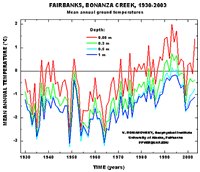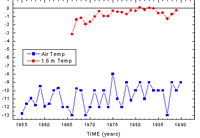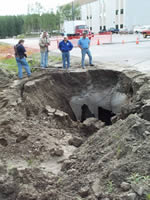How rapidly is permafrost changing and what are the impacts of these changes?
Vladimir E. Romanovsky
Associate Professor
Geophysical Institute UAF
Fairbanks, AK
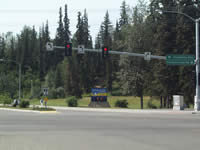 |
| Figure 1. One of the hot afternoons in Fairbanks, Alaska in June 2004. |
What is permafrost? On a hot day in Fairbanks, Alaska (Figure 1), it is very hard to imagine that anything could be frozen around here. The sun is shining almost around the clock, the trees and grass are green and people try to find some good spot near the water, which is not spoiled by a myriad of mosquitoes. Yet, in less than 100 yards from the University of Alaska Fairbanks corner, within a large area covered by tiny black spruce trees and a thick moss layer, the soil is frozen just some 30 to 40 centimeters below the moss surface. This soil will be frozen during the entire summer. No big surprise, it was frozen for the last several thousand years and maybe even longer. That is why we call this natural phenomena "permafrost", or "perennially frozen ground". Only the upper 30 to 100 cm of soils (called the active layer) thaws every summer and then completely refreezes during the winter. Typical thickness of permafrost around Fairbanks is about 50 meters, but varies between a few meters and 150 m and more.
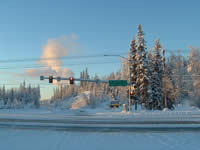 |
| Figure 2. Wintertime in Fairbanks, Alaska. |
Why does permafrost still exist in Fairbanks with such warm summers? Because the average temperature during the year is the most important factor for permafrost existence. Winters in Fairbanks are cold and long (Figure 2). So, the average air temperatures here are typically between -2 and -5°C. The insulating effect of snow makes the average temperatures in permafrost higher (typically from -0.2 to -2°C) that brings permafrost in Fairbanks area to the edge of instability (long-term thawing).
Permafrost gets colder and thicker northward. Within the northern foothills of the Brooks Range permafrost is already -2 to -5°C cold and about 200 meters thick. On the Alaskan Arctic Plain, permafrost could be as cold as -9 to -11°C cold and up to 650 meters thick.
The large observed and predicted future climatic changes will inevitably change the energy and mass fluxes at the land surface and, as a result, the near-surface and subsurface physical conditions in the Arctic and Sub-Arctic. This will trigger changes in ecosystems and infrastructure because the stability of these systems in the north relies on the stability of ice that, so far, holds these systems together. In losing permafrost, we are losing the stability of systems.
What is happening to permafrost? The long-term records of the near-surface permafrost temperature, obtained from different parts of the permafrost zone in northern regions, show a significant warming trend during the last 30 years (Table 1). Ground temperature trends generally follow the trends in the air temperatures with a more pronounced warming in the lower latitudes (between 55° and 65° North). This recent climate warming brought soil temperatures to a surprisingly high level, about 1 to 3°C warmer than long-term averages (Figure 3). Within some areas, the permafrost temperatures are very close to 0°C (Figure 4) and at some sites long-term permafrost degradation has already started (Fedorov, 1996; Osterkamp et al., 2000; Jorgenson et al., 2001; Fedorov and Konstantinov, 2003; Gavriliev and Efremov, 2003).
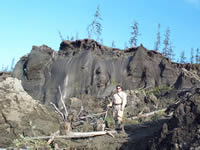 |
| Figure 5. Extremely ice-rich permafrost (so called "Ice Complex") at the Duvaniy Yar site on the Kolyma River, East Siberia (photo by S. Davidov). |
If recent trends continue, it will take several centuries to millennia for permafrost to disappear completely in the areas where it is now actively warming and thawing. However, negative consequences of this degradation will be pronounced from the very beginning because the highest ice content in permafrost usually is found in the upper few tens of meters (Figure 5).
What happens when permafrost starts to thaw?
While the increase in permafrost temperatures may change many of
its physical properties that can have some negative effects on infrastructure,
the major threshold occurs when permafrost starts to thaw from its
top down. At that moment, many processes (some of them very destructive)
will be triggered or intensified. The most significant impacts on
ecosystems, infrastructure, carbon cycle and hydrology will be observed
in areas where permafrost contains a considerable amount of ground
ice in the upper few meters. Even in the polar areas, where permafrost
will still be stable, the depth of the seasonal active layer will
increase significantly if present trends continue.
| Recent trends in permafrost temperatures measured at different locations (modified from Romanovsky et al., 2002) |
|||
| Country | Region | Permafrost temperature change/trends | Reference |
| USA | Trans-Alaska pipeline route (20 m), 1983-2003 | +0.6 to +1.5°C | Osterkamp and Romanovsky, 1999; Romanovsky and Osterkamp, 2001; Osterkamp 2003 |
| Barrow Permafrost Observatory (15 m), 1950-2003 | +1°C | Brewer 1958; Romanovsky et al., 2002 | |
| Russia | East Siberia (1.6-3.2 m), 1960-1992 | +0.03°C/year | Romanovsky et al., 2001 |
| North of West Siberia (10 m), 1980-1990 | +0.3 to +0.7°C | Pavlov, 1994 | |
| European North of Russia, continuous permafrost zone (6 m), 1973-1992 | +1.6 to +2.8°C | Pavlov, 1994 | |
| European North of Russia, discontinuous permafrost zone (6 m), 1970-1995 | up to +1.2°C | Oberman and Mazhitova, 2001 | |
| Canada | Alert (15 m), 1995-2000 | +0.15°C/year | Geological Survey of Canada data: Smith et al., 2003 |
| Northern Mackenzie basin (28 m), 1990-2000 | +0.1°C/year | Geological Survey of Canada data: Couture et al. (2003) | |
| Central Mackenzie basin (15 m), 1985-2000 | +0.03°C/year | Geological Survey of Canada data: Couture et al. (2003) | |
| Northern Quebec (10 m), late 1980s - mid 1990s | -0.1°C/year | Allard et al., 1995 | |
| Europe/Norway | Juvvasshøe, southern Norway Janssonhaugen, Svalbard |
+0.5 to +1.0°C +1° to +2°C |
Isaksen et al., 2001 Isaksen et al., 2000 |
| Asia/China | Qinghai-Tibet Plateau (1970s-90s) | +0.1 to +0.3°C | Huijin et al., 2000 |
| Asia/Kazakstan | Northern Tien Shan (1973-2003) | +0.2° to +0.6°C | Marchenko, 1999 and 2002 |
| Asia/Mongolia | Khentei and Khangai Mountains, Lake Hovsgol (1973-2003) | +0.3° to +0.6°C | Sharkhuu, 2003 |
Permafrost degradation can substantially change the surface hydrology in many ways. Within the area with ice-rich permafrost and poor drainage conditions permafrost degradation will lead to significant ground surface subsidence and pounding ("wet thermokarst"). The ground will become over-saturated, which could cause trees to die (Osterkamp et al., 2000; Jorgenson et al., 2001). Permafrost degradation on well-drained portions of slopes and highlands will proceed in a form of "dry thermokarst". This process will further improve the drainage conditions and lead to a decrease in the ground water content (Hinzman et al., 2003). Changes in the active layer thickness and permafrost continuity will affect ground water and river runoffs.
Northern ecological systems depend on permafrost conditions. Permafrost controls plant communities and biomass production by soil temperature, active layer thickness, moisture content, presence of unfrozen water, and surface hydrology. The changes in the permafrost thermal regime and active layer thickness can affect plant diversity and biomass. The thawing of the ice-rich permafrost within the boreal forest biome can lead to destruction of the substrate and major changes in ecosystems. In case of the "wet thermokarst" scenario of permafrost degradation, changes can result in replacement of the boreal forest with wetlands. In case of "dry thermokarst", the boreal forest ecosystems may be replaced by steppe-like habitats. Long-term permafrost degradation (even without active thermokarst processes) will continuously improve conditions for the subsurface water drainage (especially in sandy soils) that will lead to increased dryness of soils, putting significant stress on vegetation. Improved drainage conditions will also lead to shrinkage of numerous ponds within the degrading permafrost area dramatically affecting aquatic ecosystems (Yoshikawa and Hinzman, 2003).
Significant amounts of carbon are now sequestered in perennially frozen soils (permafrost) and within the active layer, which thaw every summer but completely re-freeze during the following winter, where the organic matter decomposition is slow. That is why the majority of northern ecosystems are apparently carbon sinks at present time. Climate warming and drying caused by this warming permafrost degradation will change this situation. A thicker, warmer and dryer active layer will be much friendlier for microbial activities during the summer. Significantly later freeze-up of this layer in winter and warmer winter temperatures (that means much more unfrozen water in it) will considerably enhance the microbial activities during the winter. So, the arctic and sub-arctic ecosystems could turn into a source of CO2 (especially on an annual basis) very soon. Further permafrost degradation and formation of taliks will amplify these changes because a layer that will not freeze during the entire winter (talik) will appear above the permafrost, where microbial activities will not cease during the winter. In the area of "wet thermokarst" formation, new and significant sources of CH4 will be developing.
Thaw settlement related to permafrost degradation is presently responsible for damage to houses, roads, airports, military installations, pipelines, and other facilities founded on ice-rich permafrost (Osterkamp et al., 1997). Any natural increase in the mean annual surface temperature of permafrost and subsequent thaw settlement would create severe maintenance problems for facilities in the Arctic and Sub-Arctic, adding to effects already being observed (Figure 6). Some structures, airports, and roads might have to be abandoned if funds are not adequate to continue repairs (Esch and Osterkamp, 1990).
Gallery of Permafrost Photographs
Permafrost Gallery I - Page 1 | 2
Permafrost Gallery II - Page 1 | 2 | 3
Publications
Allard, M., B. Wang and J.A. Pilon, 1995. Recent cooling along the southern shore of Hudson Strait, Quebec, Canada, documented from permafrost temperature measurements. Arctic and Alpine Research, 27:157-166.
Couture, R., S. Smith, S.D. Robinson, M.M. Burgess and S. Solomon, 2003. On the hazards to infrastructure in the Canadian North associated with thawing of permafrost. Proceedings of Geohazards 2003, Third Canadian Conference on Geotechnique and Natural Hazards, pp. 97-104. Canadian Geotechnical Society.
Esch, D.C., and Osterkamp, T.E. (1990) Cold region engineering: Climatic warming concerns for Alaska, J. Cold Regions Engineering, 4(1), 6-14.
Federov, A.N., 1996: Effects of recent climate change on permafrost landscapes in central Sakha. Polar Geography, 20, 99-108.
Federov, A. and P. Konstantinov, Observations of surface dynamics with thermokarst initiation, Yukechi site, Central Yakutia. In: Proceedings of the VII International Permafrost Conference, Switzerland, July 21-25, pp. 239-243, 2003.
Gavriliev, P. P. and P. V. Efremov, Effects of cryogenic processes on Yakutian landscapes under climate warming. In: Proceedings of the VII International Permafrost Conference, Switzerland, July 21-25, pp. 277-282, 2003.
Hinzman, L.D., Kane, D.L., Yoshikawa, K., Carr, A., Bolton, W.R., and M. Fraver, Hydrological variations among watersheds with varying degrees of permafrost. In: Proceedings of the VII International Permafrost Conference, Switzerland, July 21-25, pp. 407-411, 2003.
Isaksen, K., P. Holmlund, J.L. Sollid and C. Harris, 2001. Three deep alpine-permafrost boreholes in Svalbard and Scandinavia. Permafrost and Periglacial Processes, 12:13-25.
Jorgenson, M.T., Racine, C.H., Walters, J.C., and Osterkamp, T.E., 2001: Permafrost degradation and ecological changes associated with a warming climate in central Alaska. Climatic Change, 48(4), 551-571.
Klimatologicheskii spravochnik SSSR, (1961-1992). Vypusk 24, po Yakutskoi ASSR, severnoi chasti Khabarovskogo kraya, Magadanskoi oblasti i severnoi chasti Kamchatskoi oblasti. Meteorologicheskie ezhemesyachnie dannye za 1961-1992, chast' II, VII, Temperatura pochvy, tumany, grozy, meteli i grad, Gidrometeoizdat, Leningrad (In Russian).
Marchenko, S.S., Results of monitoring of the active layer in the northern Tien Shan mountains, Earth Cryosphere, v. VI, 3, 25-34, 2002 (in Russian).
Oberman, N.G. and G.G. Mazhitova, Permafrost dynamics in the north-east of European Russia at the end of the 20th century. Norwegian Journal of Geography, 55, 241-244, 2001.
Osterkamp, T.E., 2003. A thermal history of permafrost in Alaska. Proceedings of Eighth International Conference on Permafrost, Zurich, pp. 863-868.
Osterkamp, T.E., D.C. Esch, and V.E. Romanovsky, Infrastructure: Effects of climatic warming on planning, construction and maintenance, Proc. of the BESIS Workshop, Univ. of Alaska, Fairbanks, AK, pp. 115-127, 1997.
Osterkamp, T.E., and V.E. Romanovsky, Evidence for warming and thawing of discontinuous permafrost in Alaska, Permafrost and Periglacial Processes, 10(1), 17-37, 1999.
Osterkamp, T.E., L. Vierek, Y. Shur, M.T. Jorgenson, C. Racine, A. Doyle and R.D. Boone, 2000: Observations of thermokarst and its impact on boreal forests in Alaska, U.S.A. Arctic, Antarctic and Alpine Research, 32, 303-315.
Pavlov, A.V., Current changes of climate and permafrost in the Arctic and Sub-Arctic of Russia, Permafrost and Periglacial Processes, 5, 101-110, 1994.
Romanovsky, V.E., and T.E. Osterkamp, Permafrost: Changes and Impacts, in: R. Paepe and V. Melnikov (eds.), "Permafrost Response on Economic Development, Environmental Security and Natural Resources", Kluwer Academic Publishers, 297-315, 2001.
Romanovsky, V. E., Shender, N. I., Sazonova, T. S., Balobaev, V. T., Tipenko, G. S. and Rusakov, V. G., Permafrost Temperatures in Alaska and East Siberia: Past, Present and Future, in: Proceedings of the Second Russian Conference on Geocryology (Permafrost Science), Moscow, June 6-8, pp. 301-314, 2001.
Romanovsky, V., M. Burgess, S. Smith, K. Yoshikawa, and J. Brown, Permafrost Temperature Records: Indicators of Climate Change, EOS, AGU Transactions, Vol. 83, No. 50, 589-594, December 10, 2002.
Sharkhuu, N., Recent changes in the permafrost of Mongolia. In: Proceedings of the VII International Permafrost Conference, Switzerland, July 21-25, pp. 1029-1034, 2003.
Smith, S.L., M.M. Burgess and A.E. Taylor, 2003. High Arctic permafrost observatory at Alert, Nunavut - analysis of a 23-year data set. Proceedings of the Eighth International Conference on Permafrost, 1073-1078.
Yoshikawa, K. and L.D. Hinzman, Shrinking thermokarst ponds and groundwater dynamics in discontinuous permafrost near Council, Alaska, Permafrost and Periglacial Processes, 14(2): 151-160, 2003.
7/13/2004



